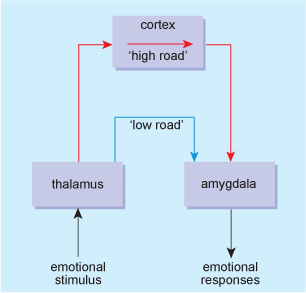2.4 The amygdala and emotion
The amygdala, a structure in the limbic brain, plays a central role in our emotional perception and our responses (LeDoux, 1998). The amygdala has a similar role in other mammals such as rats and monkeys – this is important and relevant, given the use of animal models in scientific studies to study several aspects of issues related to emotions and emotional disorders, as will become clearer if you study the related OpenLearn course Understanding depression and anxiety [Tip: hold Ctrl and click a link to open it in a new tab. (Hide tip)] .
Parts of the amygdala are involved in triggering the responses we associate with fear, such as submission, fleeing, or staying rooted to the spot (i.e. freezing). Other regions elicit feelings of ‘bliss’ or peacefulness, while still others evoke aggression and attack.
Life-or-death situations demand extremely rapid responses, which the amygdala is well-placed to mediate. For instance, if you are out walking at night in an unfamiliar neighbourhood and hear a sudden thump behind you it may make you jump in alarm. Your heart will be beating hard and all your senses will be alert – because your ‘fight or flight’ reaction has been triggered. Information from the senses (from hearing, in this case) reaches the amygdala, which triggers the ‘fight or flight’s stress response. There are two routes via which this sensory information can get to the amygdala (Figure 5).
One route, known as the ‘low road’ or the ‘quick and dirty’ route, carries relatively crude information from the ear to the amygdala via the thalamus: ear → thalamus → amygdala. This is the subcortical route – i.e. it is ‘below the cortex’ and is fast and unconscious – a response is triggered in a split second before you are aware of what actually made you jump. The other route, the ‘high road’ is a cortical route, as it goes via the cortex: ear → thalamus → cortex → amygdala. It is longer, slower and indirect, but provides more detailed information about the stimulus, and allows conscious awareness and assessment of it. So you may feel rather sheepish, on realising that it was just a cat jumping onto a dustbin!
The quick unconscious route elicits an ‘automatic’ reaction around a fiftieth of a second (20 milliseconds or thousandths of a second) after the sound enters your ear. The longer, slower route via the cortex takes 200 milliseconds (a fifth of a second) – this is how long it takes before you are consciously awareness of what made you jump. This is still very quick, but the unconscious route is 10 times faster.

The above also shows that our emotions can be triggered extraordinarily rapidly and unconsciously. If we are in a very ‘reactive’ state, we may find ourselves responding emotionally to situations and stimuli without thought or judgement, perhaps with disastrous results. Fortunately such initial and unconsciously triggered emotional responses can be modified and corrected by conscious appraisals into more considered and appropriate responses. For instance, if someone knocks into you, your response will depend on whether you think the person did this deliberately or accidentally.
We will revisit the role of appraisal, and of the amygdala in emotional responses, in the related OpenLearn course Understanding depression and anxiety.
Activity 2 The pathways of the fear reaction
Following a sudden sound, which of the following pathways, A to E, provides (a) the unconscious route that mediates the fear reaction; (b) the conscious route that mediates the fear reaction and also allows appraisal of the stimulus that caused the fear?
- A.ear → amygdala → cortex → hippocampus → emotional response
- B.ear → orbitofrontal cortex → thalamus → emotional response
- C.ear → thalamus → amygdala → emotional response
- D.ear → thalamus → cortex → emotional response
- E.ear → thalamus → cortex → amygdala → emotional response.
Answer
(a) C; (b) E.
